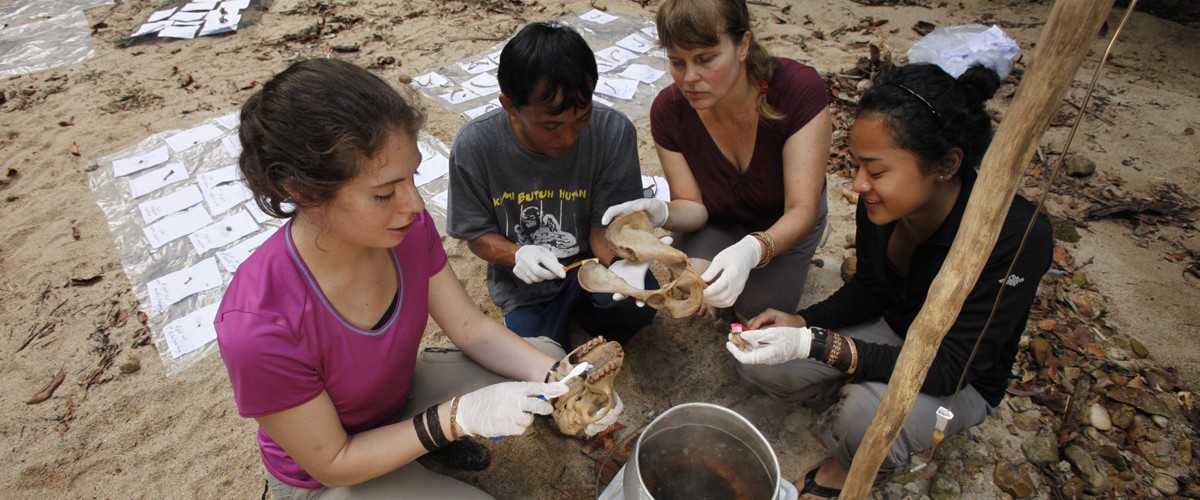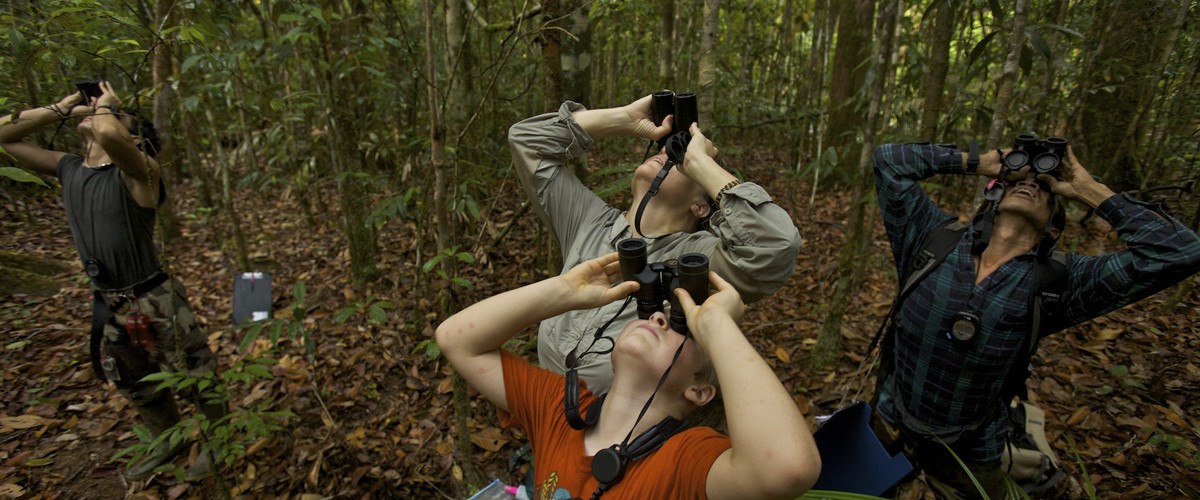By Ahmad Rizal, Research Manager
On May 10, the research team hiked back to Cabang Panti Research Station to resume work after a two-week break for the Idul Fitri holiday. The next day, all the field research assistants started searching for new orangutans to follow and resumed phenology monitoring as well. That same day, one of the field assistants, Dang, found a flanged male orangutan in the forest and followed him until he made a nest for the night. We continued data collection as usual, following the male from morning nest to night nest, collecting behavioral data, and urine, feces and fruit samples. We followed this male for 3 full days, before losing him on the 4th.
After that follow series, we began searching for orangutans again. On May 21, Dang found another flanged male orangutan, who we identified as Alfred – a very large male that we come across fairly often within the research station vicinity.
The next day, on May 22, the field team woke up at 3AM to prepare for the day’s follow. The plan was that Hassan would collect data on the iPad, Toto would collect GPS data, and Ishma would collect samples. They left camp at 4AM to hike to the location where Alfred made his nest the night before, deep in the peat swamp habitat.
After arriving, they waited for the orangutan to wake up. Alfred woke up at 5:34, then urinated and defecated. Soon after, he travelled to a Ficus sondaicus tree to begin eating its fruit. Suddenly, at 5:55, a female orangutan arrived at the same feeding tree and also began eating the fruits. This is what we call a ‘party’ – when two or more orangutans are within 50 meters or fewer of each other.

The field assistants soon noticed that this other party individual appeared to be an adult female. Toto began trying to take photos and videos, though it was still quite dark out, which made it difficult. The assistants continued to try to get a better view to see who this other orangutan was. The orangutans were also positioned very high up in the tree canopy, which made it even more difficult to take photos.
Eventually, they were able to get a better look, and based on the morphology, facial shape and other characteristics, thought that this orangutan looked like a female named Tari. But they then wondered where Tari’s daughter was, because we know Tari to have a daughter in the juvenile age class (4-8 years old), who was given the name Tawni. Tawni is now estimated to be 7 years and 10 months old.
The assistants continued to try to get better photos. Suddenly, they captured a video and realized there was a baby hiding on the mother’s body!! They could only see the tiny outline of a baby and its very little feet. After looking more closely at this video, and taking more, they estimated that this newborn baby is only 1 or 2 months old.

Later in the morning, the assistants called for backup to help take data for this party. Two other assistants, Sahril and Yogi, then joined the follow. Ishma, a laboratory assistant, who was out collecting samples, returned to camp where I was, and told me that there was a mother-infant pair partying with Alfred. I was very surprised and happy. When Ishma told me that the mother looked like Tari, I prepared a camera with better zoom, and went over to where the orangutans were.
By the time I arrived at the peat swamp, the party was over, and the mother and Alfred had gone separate ways. I stayed with the assistants who were following the mother and infant, who were by then resting in a large tree. They rested there for a long time, and eventually at 14:10, the mother began traveling towards a Mezzettia leptopod tree that bore many fruits. The mother began eating fruit from the tree, and then I could see the baby for the first time. Indeed, it was very small. So small that it was almost hard to see on the mother’s body.
The assistants continued to collect data while the orangutan ate. I began trying to find a more open location to take photos and videos. The mother ate for a long time, then at 17:16 she began building a nest to sleep in. That day, we didn’t get many good quality photos or videos. We were unable to tell if the baby was male or female, because it was almost always hidden by the mother’s body. We could occasionally see the face of the little baby and it was so cute!
We made the decision to keep trying to follow the mother and baby orangutan for 10 full days. Normally, we follow orangutans for only 5 days, but since it is uncommon to see a baby this young, we wanted to make sure to collect as much data as possible. As of today, May 27th, when I am writing this article, we are still following these orangutans. We have not encountered any difficulties because the weather has been quite good and the mother orangutan has been moving slowly while the baby clings to her body. It has still been quite difficult to get good photos and videos of the baby, because it is always hiding within the mother’s fur. It almost seems like the mother doesn’t want her baby to be on camera!


Otherwise, the follows have been going well. The mother usually wakes up around 6AM. Throughout the day she seems to be very habituated and not care about our presence. She does not make many kiss squeak vocalizations at us, which typically indicates that an orangutan is disturbed by the presence of observers. She has been spending most of her time eating (mostly Ficus) and resting. She is not traveling very much. We think this is because the baby is still very small, and its presence on the mother’s body makes her movement more limited. She may also still be resting more/recovering after giving birth.
Today, on May 27, I returned to the field to try to take photos and videos with a higher quality camera. However, it has still been quite difficult to get clear photos of the baby. Maybe it is camera shy! We are still unsure of the gender of the baby. It can be very difficult to see the genitals when the baby is still this small.
We still have a lot to learn about this new baby (and we will have to give it a name eventually!) but it is always so exciting to have a new baby orangutan in Gunung Palung. The birth of new babies is always a promising sign that we are doing good to help the survival of wild orangutans. I am so excited to share this news with you all and I will continue to pray that this baby and mother are always healthy and continue to thrive at Cabang Panti Research Station.

——————————————————————————————————————–
Management of Cabang Panti Research Station is conducted by the Gunung Palung National Park Office (BTN-GP) in collaboration with Yayasan Palung (YP)/Gunung Palung Orangutan Conservation Program (GPOCP). Scientific research is carried out in conjunction with the Universitas Nasional (UNAS) and Boston University.









